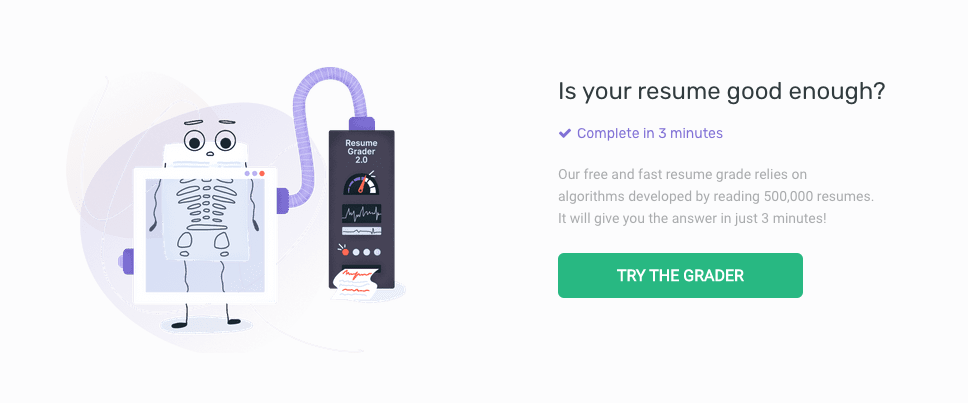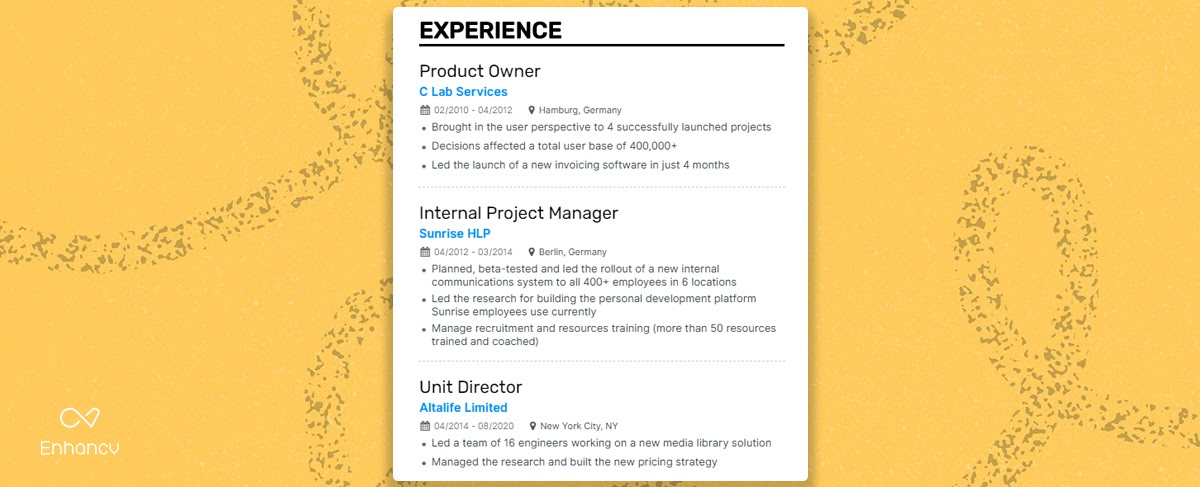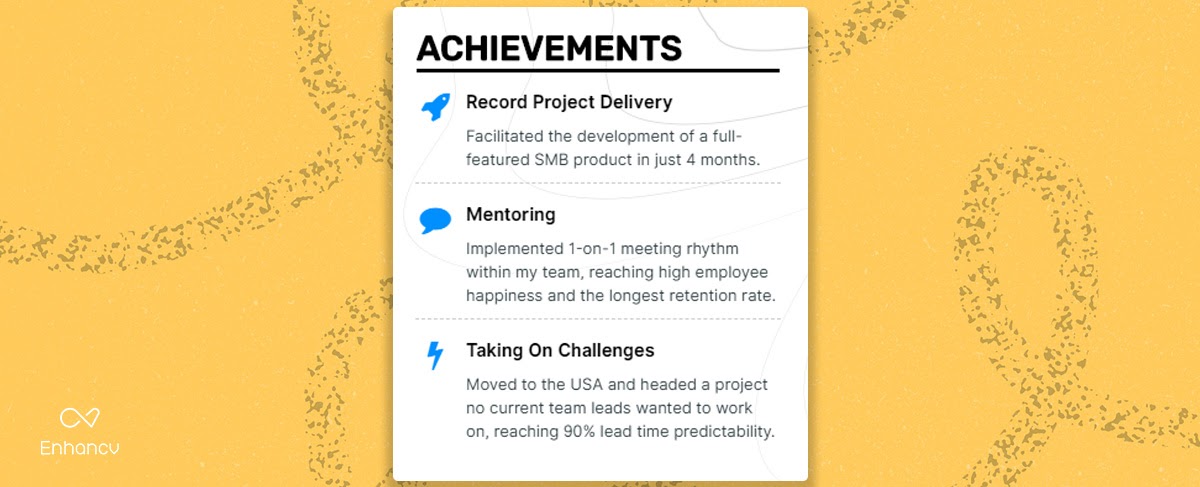Quick Answer:
The rule of thumb is 10 to 15 years, but it depends on relevance. Divide work experience into ""relevant"" and ""recent"". Consider whether the experience is relevant to the position you're applying to and tailor your resume accordingly. For significant career changes, skip irrelevant experience, but include relevant awards and courses. Showcase achievements throughout your career and use a summary section to express personality and explain your industry experience. Gaps in work history can be filled with volunteer work or relevant courses."
How far back should your resume go?
If you’ve ever sat down crafting your resume, I bet this is a question that has popped in your head at least once.
Should you go five years back? Ten? Fifteen?
Well, I’m sorry to be the one to break it for you but there is no one-fits-all answer to this question. It depends. And it does so on a lot of factors.
Don’t worry though. You don’t have to fire up the DeLorean just yet. At Enhancv we pride ourselves on having some of the best resumes in the industry, so we believe we can give a solid answer to your question.
In this article, we’ll go over how far back you should go on your resume, as well as how to determine relevant experience on a case-by-case basis and how to feature older experience. By the end of reading it, you’ll have the chops to write a pretty good-looking resume.
So…
How far back should your resume go?
Upload & Check Your Resume
Drop your resume here or choose a file. PDF & DOCX only. Max 2MB file size.
The rule of thumb is to go 10 to 15 years back on your resume. We’d go a step further than that and suggest longer work experience be divided into “relevant” and “recent”. It just makes it easier to comprehend.
See, many recruiters consider experience older than 15 years to be irrelevant. At Enhancv we tend to disagree. Depending on your experience and the skills you have acquired throughout the years going 20 years back can be a really valuable thing to include.
Look at it that way, different positions require a different amount of experience. You wouldn’t hire a C-level executive if they didn’t have a proven track record, would you?
The most important thing to consider is whether or not the experience is relevant to the position you’re applying. That’s why if you’ve switched careers at some point back in time, then it’s best to stick with what would be valuable to the place you’re applying.
How long should a resume in 2020 be?
Back in the days keeping your resume a single page used to be a strategic thing to do.
It was cheaper to print and easier to store.
But in the 21st century, most recruiters and employers have long forgotten what sifting through paper mountains of applications feels like. It’s all digital now.
A digital resume gives you the chance to create a high-impact and well-structured application that can go over one page.
And even though we wrote a whole article on resume length in 2020 the answer remains the same — it’s all about staying relevant to the position you’re applying.
If you’re certain the employer wants you to go in detail about your work experience then do just that.
If you have a lot of relevant work experience, backed by volunteer work and side projects and a single page isn’t enough, then definitely expand on a second page.
Can you leave jobs off a resume?
Definitely.
See, a resume shouldn’t be the place where you list every single job you’ve ever had. Your resume should be the place that shows recruiters your skills, relevant previous work, and a bit about who you are.
That’s why if you’re applying for a senior Java developer position at a tech startup you can feel free to skip the three months you worked at Papa Johns during your college years.

How to determine how far back you should go on your resume?
Choosing what experience to include varies from one job position to another.
What may be relevant for one employer, might be totally uninteresting to another. That’s why it’s important to tailor your resume to the specific place you’re applying to.
And it’s why we’ve also developed thousands of free resume templates for you to use.
When you decide on how far back to go on your resume keep a couple of factors in mind.
- Relevancy of each job you’ve had.
Think of what will be valuable to the employer. What are they looking for? Go over the job description and study it in detail. Do your research and try to find what the hiring company is looking for and how you can be helpful to them. - It’s most likely in the job description.
Most job ads have already promptly stated how many years of experience they’re looking for. Pay attention to little things and try to do a bit of digging. Often employers would place two or three listings on different websites, or they will have a “Careers” page where they go in-depth about the job. - What’s the level of the role?
It’s normal for senior roles to require 15 years and more of experience. For junior none or some experience is what they’re looking for. Every position in-between is, well, somewhere between five and fifteen years. - Go with what stands out the most.
Recruiters are looking for something that stands out in the sea of applications. If you managed to improve the conversion rate of a business you worked at 15 years ago, then make sure to put in your resume. Showing real-life experience can sometimes be more valuable than showing where you graduated in 1994.
When to go back 5 to 10 years on a resume?
One of the most common reasons why you’d want to limit the amount of work experience you show is a significant career change.
There’s nothing wrong with deciding to switch careers, it’s just that your past experience may not be that relevant to what the employer is looking for.
So, if you graduated from business school, but decided to switch careers and become a lawyer instead, you may want to skip the experience you have in the business field if it isn’t relevant. Of course, in some cases, that experience will be relevant and that’s when you use it to your advantage (more on how to feature old experience below).
You can also include any awards, certificates, and courses relevant to the position in order to boost your application.
When to go back 10 to 15 years on a resume?
It’s acceptable to go back 10 to 15 years back on your resume when you’re an experienced professional with three, four, five, or more workplaces.
Going this far back on your resume is a great way to back up your work experience with results, so try to showcase the things you’re most proud of during each stage of your career.
Listing all companies you’ve worked at, followed by your responsibilities may seem like a good idea at first. However, employers and recruiters are way more interested in learning how you managed to impact the businesses you’ve been a part of, rather than learning your day-to-day.
And, once again, make sure to tailor your resume to what the employer is looking for. For example, if you have previous experience in both marketing and sales, but you’re looking to join the sales team in the company you’re applying for, then your sales experience should be at the core of your resume, while your marketing experience is nice-to-have but not relevant.
When to go further than 15 years?
The world today is moving so quickly that what was relevant 15 years ago is no longer something of interest for most recruiters.
If you’re applying for a C-level position, then yes, definitely make your resume as detailed as possible, featuring everything that will show you’re the right person for the job.
If you’re applying for a mid-level position and you have a diverse career in multiple industries, then just go with what’s relevant and skip the rest.
How to feature older experience on your resume?
Powerful resumes have a secret.
They’re focused, compact, and never feature more than they have to.
A lot of it comes with the right resume layout. In fact, we’ve written an in-depth piece on how to choose and leverage a content outline to your advantage. Go read it here.
One thing that you can do when featuring experience older than 15 years on your resume is to brainstorm relevant highlights from your career and put them in the spotlight rather than featuring them in the “Experience” section.
Another option is to place all older experience in a single section, however, we think this just ends up looking messy and confusing given that most of the templates you can download online aren’t designed for this sort of stuff.
How to structure an experience section?

An experience section made with the Enhancv online resume builder.
There are only two ways to structure your experience section.
One is the well known chronological order. You put your most recent job and then follow everything in chronological order.
The second one is to place your most relevant position first.
Our advice? Go with a mix. As we said above, brainstorm the highlights of your career. Put them in a “Highlights” section. Then, keep a chronological order for your experience section. It allows recruiters to track the development of your career better.
How to address gaps in your work history?
Gaps in work history are actually pretty common.
If you were (or currently are) on maternity leave, it’s best to point it out. After all, parenting is a full-time job, moreover, it’s one that requires you to be very organized.
Also, make sure you fill that gap period with volunteer work or courses you’ve attended that are relevant to the position you’re applying for.
Showing old work experience in a more interesting way.
Let’s be honest. Sometimes resumes can be pretty boring. That’s why it’s best to feature any old experience in a visually pleasing way. In other words, you want recruiters to give them attention rather than just glance over.
Achievements

Create an achievements section like this one with our online resume creator!
One of the best ways to showcase HR what you value and you’re most proud of is to feature your achievements throughout your career.
The best thing about this section is that it helps your resume stand out by packing a lot of valuable information without wasting too much space.
Summary
The summary of your resume is one of the most powerful sections you can have. It allows you to express personality, show who you are, and most importantly, it’s a great place to explain your year-long industry experience.
You don’t have to include every job you’ve had in the “Experience” section, but you can show how long you’ve been working in the field with a single sentence.
Strengths
Sometimes you can gain a lot of valuable and relevant experience for the job you’re applying, however, the previous position itself may not be as relevant.
Well, packaging it in a “Strengths” section is a great way to show that you’re organized and you can work well under pressure for example.
Volunteering
At Enhancv we’re strong proponents of volunteering and working without pay. And that’s because people become better leaders and professionals when they participate in events without receiving any immediate return.
HR specialists know that and that’s why they love it when applicants have strong volunteering experience.
Ready to build the best resume you’ve ever had?
Choose from over 530 resume examples!
If we had to answer the question of how back you should go on your resume, the answer is one — it depends.
And, it’s up to you to sit down and evaluate what is most relevant to the position you’re applying to. Grab everything that we covered above and use it in a way that is best suitable to your needs. There is no one-fits-all here, and if someone’s saying that there is, oh well, you guessed it.
Make one that's truly you.



